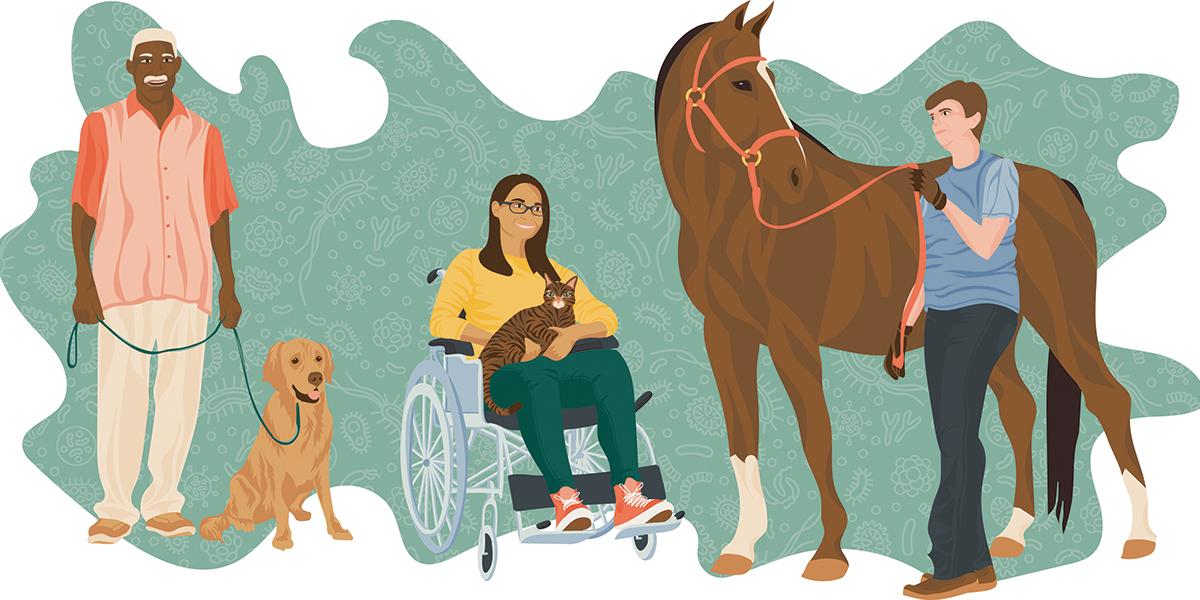Keeping superbugs at bay
A new CVM team aims to mitigate antimicrobial resistance through a previously underexplored avenue — domesticated dogs, cats, and horses

A new CVM team aims to mitigate antimicrobial resistance through a previously underexplored avenue — domesticated dogs, cats, and horses
Illustration by Megan Murrell
Last year, the Centers for Disease Control and Prevention estimated that 35,000 Americans die from antibiotic-resistant infections each year. “At a national level, people are starting to pay more attention to antimicrobial resistance,” says Jennifer Granick, DVM, MS, PhD, DACVIM, associate professor in the Department of Veterinary Clinical Sciences at the University of Minnesota College of Veterinary Medicine (CVM). “There has been a large focus on antibiotic use in human medicine and agriculture, but the conversation has largely ignored the animals that share our environment, homes, and even our ice cream cones — our pets!”
Veterinarians often treat their client’s household pets and horses with medications from the same drug classes that human physicians prescribe their patients. That’s why, last fall, a team at the CVM launched the Antimicrobial Resistance and Stewardship Initiative.
“Nearly 70% of households in the United States own a pet,” says Granick. “That number is not inconsequential. And most people do not live on or near a farm — they are more likely to be exposed to antibiotics through their own pet than through agriculture.” This new initiative is aimed at developing a system for robust companion animal disease surveillance to learn more about antibiotic-resistant infections in the pet population, as well as how antibiotics are used by veterinarians treating dogs, cats, horses, and other companion animals.
The initiative recently received $175,000 in funding through the emerging zoonotic and infectious disease category of the College’s Signature Program from the Office of the Associate Dean of Research. This grant is helping Granick and collaborators Amanda Beaudoin, DVM, PhD, DACVPM, director of One Health Antibiotic Stewardship at the Minnesota Department of Health, Jeff Bender, DVM, MS, professor at the U of M’s School of Public Health and adjunct professor at the CVM, Randy Singer, DVM, PhD, professor in the Department of Veterinary and Biomedical Sciences at the CVM, and Christine Ward, DVM, PhD, MVSc, DACVIM, assistant clinical professor in the Department of Veterinary Population Medicine at the CVM, establish and pilot Companion Animal Veterinary Surveillance Network-Minnesota (CAVSNET-MN), a passive automated surveillance system for companion animal disease and treatment. Additionally, the team will conduct a pilot point prevalence survey — to collect uniform data from multiple veterinary clinics across the state over a specific time period — of antimicrobial use and resistance in Minnesota’s small animal and equine veterinary practices.
The survey aims to reveal which conditions usually lead veterinarians to prescribe antibiotics, which would help the team identify disease areas that require more research. Since antibiotic use is a major modifiable risk factor for antimicrobial resistance, in human medicine, physicians are decreasing the duration of treatment with antibiotics. But veterinarians do not yet have baseline data on prescription duration, so this survey could provide such data to help identify areas where the duration could be reduced.
“We want to know, why do we veterinarians choose certain drugs? Why do we treat for as long as we do? If we could do the testing we wanted, would that change the way we prescribe?
Jennifer Granick, DVM, MS, PhD, DACVIM
Once the team has finished collecting all this benchmark data and used it to help veterinarians look at the common treatment practices across the field, they can help veterinary clinics implement interventions. Then, the team hopes to eventually recapture the same data in the future to measure their effort’s impact.
The researchers suspect that, from a social-emotional perspective, veterinarians prescribe antibiotics in cases of diagnostic uncertainty. In future studies, they hope to interview veterinarians to ask why they prescribe the way they do. “We want to know, why do we veterinarians choose certain drugs?” Granick says. “Why do we treat for as long as we do? If we could do the testing we wanted, would that change the way we prescribe?” Granick says that, when confronted with diagnostic limitations, a lot of veterinarians are weighing whether the outcome of prescribing is less dangerous than inaction. “We want to find ways to support veterinarians and educate clients in those situations.”